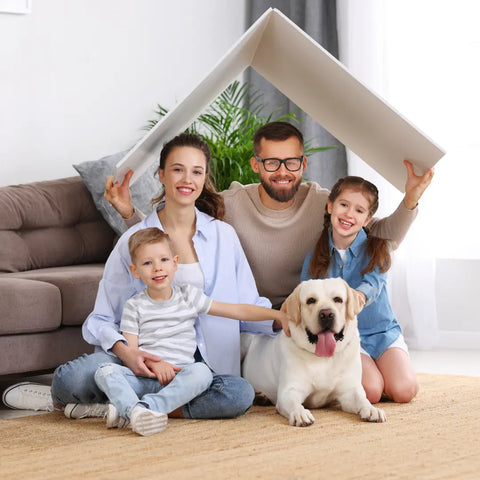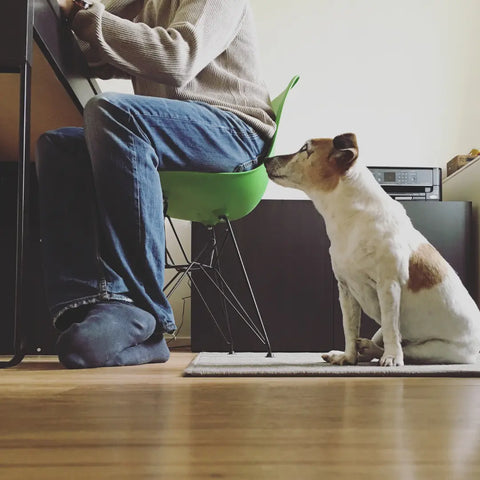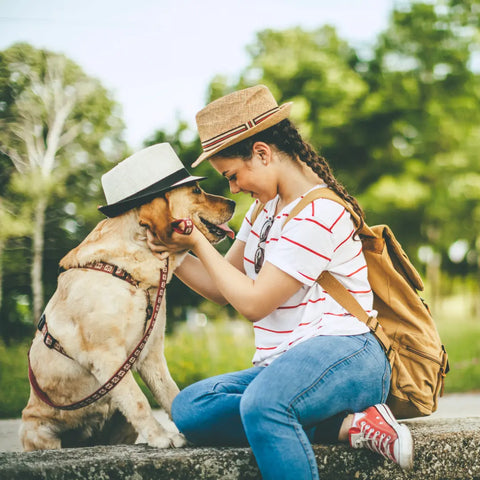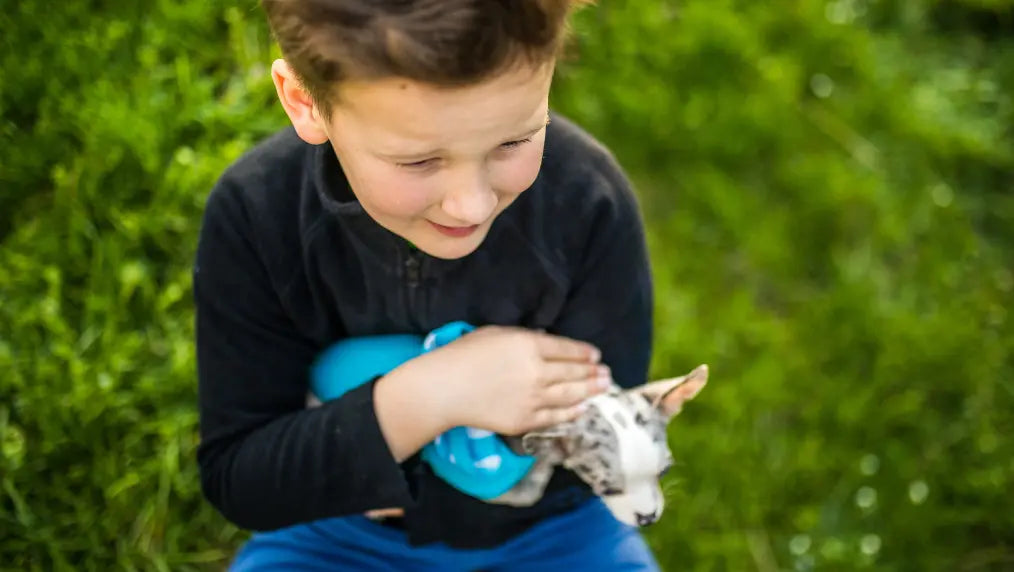Introducing a new dog to the family is a thrilling experience, but it is crucial to ensure your home is prepared for your new furry friend. After all, it’s a significant change for both you and your new dog. Especially if you have other dogs in the home.
You see, there will be an adjustment period for you, your new dog, other puppies, and other family members. Even those of the furry, feathered, and scaly kind. Needless to say you need to be prepared!
Introducing a new dog into your home, whether a new puppy or older dog, requires planning and preparation to ensure the transition is as smooth and stress-free as possible. In this blog post, we’ll dive into the essential steps you must take to ensure your new pooch feels at home in no time. From setting up a safe and comfortable living space to establishing routines and introducing a new dog to your family, we’ve got you covered. So, let’s get started!
Introducing A New Dog Home: Choosing A Dog
You’re about to get a new furry best friend! First, let’s get prepared for a (close to) seamless transition. One of the most important things to think about is your lifestyle. Are you a go-getter who loves adventure, or are you more of a couch potato? This can help you determine which dog breed will be your perfect match!
Choosing The Right Breed
Before you bring home your furry BFF, it’s important to do your homework! Why? Because different dogs come with different personalities and energy levels.
- Some love running around, playing fetch, and being active all day.
- While others are satisfied with snuggling up next to their humans on the couch.
Furthermore, think of the size of your future fur baby! If you’re looking at more giant breeds, you’ll need to ensure they have enough space to move around and live comfortably. So, research and find the perfect pooch that matches your lifestyle!
Considering The Needs of Your Family

Before introducing a new dog into your home, it’s essential to consider your family’s needs and preferences. If you have little ones or other pets, it’s best to choose a pup known to be friendly and patient with others. But if you’re flying solo and crave a loyal companion to keep you company, an independent breed might be just the ticket. Overall, by researching different breeds and their personalities, you can find the perfect pup that’ll fit right in with your lifestyle and bring joy and companionship to your home.
Introducing A New Dog Home: How To Prep
Are you getting ready to bring a new puppy into your home? Before you get too excited, make sure your casa is doggo-proofed. You want to create a safe and fun environment for your new furry friend to play, nap, and have a ball!
Plan For A New Dogs Arrival
Arrange for your dog to arrive during a weekend or when you and friends can be home for a few days. Get to know each other and spend some quality time together. For the first few weeks, you’ll want to make sure you establish a routine with your dog so they know what to expect and grow to trust you, but don’t rush your new dog into unfamiliar situations.
It can be tempting to take them to a busy park or dog park or to bring them to the pet supply store to pick out toys, but most dogs will be overwhelmed simply by the transition to your home. So keep things as quiet and consistent as possible for the first week or more. Feed and walk your dog, and come and go from work around the same times each day.
The First Day Home
- Bring your dog straight home and do not stop for errands along the way.
- Calmly introduce your pup to your family members outside, one at a time.
- Limit visitors to prevent your dog from getting overwhelmed.
- Keep your pup leashed, and lead them into the house for a tour of each room.
- Stay close to home and do not go out on any major excursions.
- Take your dog outside often for bathroom breaks, even if they were housetrained previously.
- Give your pup ample quiet time to acclimate to their new surroundings.
Dog-Proofing Your Home or Living Space

First, start by checking out every nook and cranny of your house to identify hazards like:
- Loose wires.
- Sharp edges.
- Or anything they could chew on.
Keep your pup’s safety in mind and store away any harmful products or chemicals out of their reach. Next, it’s time to set up a cozy space for your pooch. You’ll want to create a designated area where they can nap, relax, and feel at home. Grab a comfy bed and some toys, and remember to fill their bowls with food and water. That way, they can stay hydrated and energized while having a ball with their new toys.
Shopping for Supplies
Finally, ensure you’re fully stocked up on all the essentials your dog will need. This includes food, treats, a leash, a collar, and maybe even a crate for their snoozing time. Food bowls, baby gates and toys are something that you may need to add to your shopping list, and a few other household items. With these tips, you’ll be well-prepared to welcome your new furry BFF into your home!
Introducing A New Member of Your Fur Family

Introducing your dog to your family and any other pets in a relaxed and controlled setting is a great way to start things off on the right paw. Remember, a calm and comfortable environment will make for a more enjoyable experience for everyone involved. After introductions, give your pup space to explore their new digs. But don’t let them out of sight just yet! Keep a watchful eye to ensure they don’t get into any mischief and stay safe.
Routine Routine Routine
To help your dog settle in, establish a routine for feeding, exercise, and playtime. It’s amazing how quickly dogs can pick up on a schedule, and it can provide them with a sense of stability in their new environment. An established dog knows their routine and shows positive behavior when you provide guidance tailored to them.
House Training and Establishing Patience
When it comes to house training, patience is vital. This involves teaching your dog to go potty outside and letting you know when nature calls. Crate training is also essential in welcoming a new dog into your home. It involves teaching your dog to view its crate as a cozy and secure space it can call its own. This can be especially helpful during the initial adjustment period, as it provides a safe retreat for your pup to relax and feel secure. Dogs want to make you happy! When it comes to a new pet, use calm, firm, clear cues (a single, strong “no,” for example) immediately after they do something you’d like to correct or, better yet, reward them with praise, pets or treats immediately after they do something you like! It’s much easier to encourage your dog or puppy to do things you like than to stop them from doing things you don’t.
Positive reinforcement training will also help you and your puppy form a positive relationship. Consider signing up for an in-person or virtual dog obedience class with a professional dog trainer or learning about positive dog training through online videos or books from your local library. Regular training sessions and positive reinforcement will help a dog of any age acclimate better. With patience, love, and consistency, you can make introducing your new furry friend to your home successful. Remember to take things slow and steady; soon enough, your puppy or older dog will feel right at home!
See also: Grooming Puppies Early: Why It’s So Important
Introducing New Puppies or Adult Dogs: Building a Bond

Spending quality time with your dog is essential, no matter what age. It’s not just about being physically present; it’s about engaging in activities that your dog enjoys. That means: going for walks, playing fetch, or even just cuddling on the couch! Treat your pup like a family member and give them the love and attention they deserve.
Next up, training and socializing your dog is critical. Not only does training help with obedience, and food aggression, but it also strengthens the bond between you and your dog. Think about it: when your pup learns a new trick or command, they look to you for guidance and praise! Additionally, socializing your dog will help them feel more comfortable and confident in different situations, which is a win-win for both of you!
Finally, recognizing and responding to your dog’s needs is crucial. Just like humans, dogs have their personalities and preferences. Pay attention to your pup’s body language, vocalizations, and behavior. There may even be a time where your new dog experiences separation anxiety as your dog displays a positive association with you being around and their attachment to you starts to gradually increase. Are they whining? They may need to go outside. Are they cowering? Perhaps showing signs that they’re feeling scared or anxious. By responding to your dog’s needs, you’ll build trust and understanding, which is the foundation of any strong bond!
Adding a Second Dog To Your Home
Neutral territory is key! To avoid a territorial riff among both pets, do not bring your new pup home for the initial meeting. Dogs feel jealousy and it can be dangerous for your current family member to have a new puppy invade their own space. Allow both dogs to meet on neutral ground. Introduce the dogs at a park or somewhere both dogs can feel comfortable, such as your friend's home or a yard. Watch each of the canine body language styles and keep the dogs separately and together in spurts little by little. Once the two dogs seem to become accustomed to one another in the neutral environment, you can bring the new pup into the home.
Conclusion
Bringing a new dog into your life is an exciting event, but it’s also one that can be stressful for both you and your pup until you’ve settled into a routine. It can take days, months or longer for you and your new pet to adjust to each other and for your dog to acclimate to your home, especially if your new pet has lived in multiple homes or shelters in the past several weeks. Or if you already have other dogs.
In a nutshell, welcoming a new pup into your crib can be excellent if you do it right. You have to prep your pad, ease your doggo into their new digs and spend some time bonding. From the initial meeting of your new companion to a resident dog in the home, it might take some work, but it’s worth it for the snuggles and tail wags. So, if you’re considering getting a furry friend, do your homework, puppy-proof your place, and prepare for a lifetime of love and licks. With a bit of prep and TLC, you and your pup will be living your best lives together.


